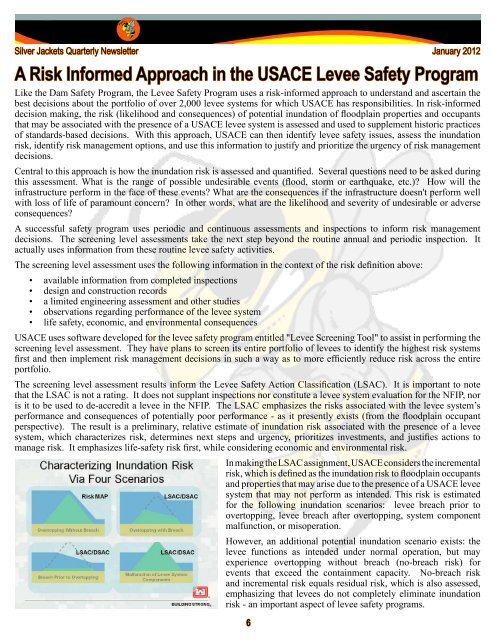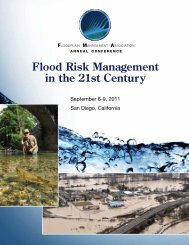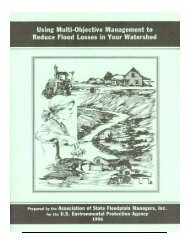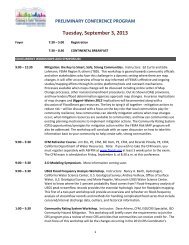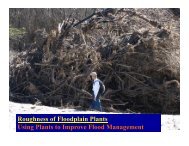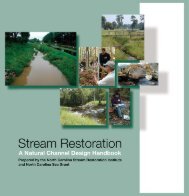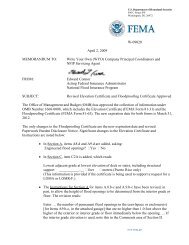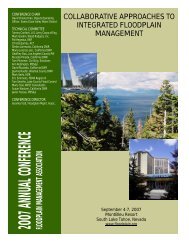Silver Jackets Quarterly Newsletter, January 2012 - Floodplain ...
Silver Jackets Quarterly Newsletter, January 2012 - Floodplain ...
Silver Jackets Quarterly Newsletter, January 2012 - Floodplain ...
You also want an ePaper? Increase the reach of your titles
YUMPU automatically turns print PDFs into web optimized ePapers that Google loves.
<strong>Silver</strong> <strong>Jackets</strong> <strong>Quarterly</strong> <strong>Newsletter</strong><br />
6<br />
<strong>January</strong> <strong>2012</strong><br />
A Risk Informed Approach in the USACE Levee Safety Program<br />
Like the Dam Safety Program, the Levee Safety Program uses a risk-informed approach to understand and ascertain the<br />
best decisions about the portfolio of over 2,000 levee systems for which USACE has responsibilities. In risk-informed<br />
decision making, the risk (likelihood and consequences) of potential inundation of floodplain properties and occupants<br />
that may be associated with the presence of a USACE levee system is assessed and used to supplement historic practices<br />
of standards-based decisions. With this approach, USACE can then identify levee safety issues, assess the inundation<br />
risk, identify risk management options, and use this information to justify and prioritize the urgency of risk management<br />
decisions.<br />
Central to this approach is how the inundation risk is assessed and quantified. Several questions need to be asked during<br />
this assessment. What is the range of possible undesirable events (flood, storm or earthquake, etc.) How will the<br />
infrastructure perform in the face of these events What are the consequences if the infrastructure doesn't perform well<br />
with loss of life of paramount concern In other words, what are the likelihood and severity of undesirable or adverse<br />
consequences<br />
A successful safety program uses periodic and continuous assessments and inspections to inform risk management<br />
decisions. The screening level assessments take the next step beyond the routine annual and periodic inspection. It<br />
actually uses information from these routine levee safety activities.<br />
The screening level assessment uses the following information in the context of the risk definition above:<br />
• available information from completed inspections<br />
• design and construction records<br />
• a limited engineering assessment and other studies<br />
• observations regarding performance of the levee system<br />
• life safety, economic, and environmental consequences<br />
USACE uses software developed for the levee safety program entitled "Levee Screening Tool" to assist in performing the<br />
screening level assessment. They have plans to screen its entire portfolio of levees to identify the highest risk systems<br />
first and then implement risk management decisions in such a way as to more efficiently reduce risk across the entire<br />
portfolio.<br />
The screening level assessment results inform the Levee Safety Action Classification (LSAC). It is important to note<br />
that the LSAC is not a rating. It does not supplant inspections nor constitute a levee system evaluation for the NFIP, nor<br />
is it to be used to de-accredit a levee in the NFIP. The LSAC emphasizes the risks associated with the levee system’s<br />
performance and consequences of potentially poor performance - as it presently exists (from the floodplain occupant<br />
perspective). The result is a preliminary, relative estimate of inundation risk associated with the presence of a levee<br />
system, which characterizes risk, determines next steps and urgency, prioritizes investments, and justifies actions to<br />
manage risk. It emphasizes life-safety risk first, while considering economic and environmental risk.<br />
In making the LSAC assignment, USACE considers the incremental<br />
risk, which is defined as the inundation risk to floodplain occupants<br />
and properties that may arise due to the presence of a USACE levee<br />
system that may not perform as intended. This risk is estimated<br />
for the following inundation scenarios: levee breach prior to<br />
overtopping, levee breach after overtopping, system component<br />
malfunction, or misoperation.<br />
However, an additional potential inundation scenario exists: the<br />
levee functions as intended under normal operation, but may<br />
experience overtopping without breach (no-breach risk) for<br />
events that exceed the containment capacity. No-breach risk<br />
and incremental risk equals residual risk, which is also assessed,<br />
emphasizing that levees do not completely eliminate inundation<br />
risk - an important aspect of levee safety programs.


